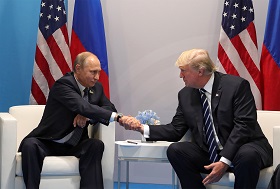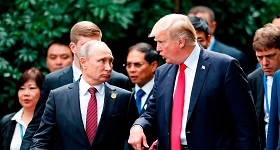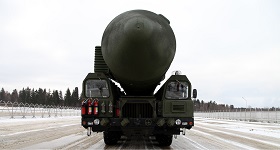INF Treaty: More than Just an Agreement
In
Login if you are already registered
(votes: 4, rating: 5) |
(4 votes) |
Ph.D in History, Senior Research Fellow, IMEMO RAN
The INF Treaty became a key factor in the de-escalation of the conflict in Europe, and in the detente in general. Even though it was not formally linked to other arms limitation agreements of the period, their complementary nature is obvious.
The INF Treaty currently has no direct formal impact on any other agreements, but it does affect them indirectly. The Strategic Arms Reduction Treaty (START) is to be either prolonged or replaced with a new agreement in 2021. It is possible that, if one of the parties withdraws from the INF Treaty, this will result in the active build-up of weapons of mass destruction with the use of short- and medium-range missiles. In such a situation, the New START would no longer work, and a new agreement would be next to impossible to sign, with all the consequences this would entail for the international security system.
The INF and New START treaties exert a deterrent effect on the other nuclear powers, even though they are not signatories. The existing agreements between the United States and Russia still indicate a continuing consensus between the two military superpowers, and possibly their readiness to join efforts on the non-proliferation of nuclear weapons and missile technologies. In other words, the regulatory capabilities of the two powers, which in the past were supported by a serious treaty framework and the mutual recognition of interests, currently represent a distant legacy of the Cold War and would not survive the termination of the INF Treaty. At the same time, the United States will not be able to find an adequate substitute for Russia as a sparring partner in the coming years and possibly even decades.
Given the changes that have taken place in the international system, what we need now is a new comprehensive arms reduction strategy that would involve all nuclear powers. We have to realise, however, that any such proposals should be extremely cautious, seeing as potential contradictions and the unwillingness to compromise could affect the current agreements. In addition to the INF Treaty, the overall position on the Korean issue is also very important: it could demonstrate the willingness of the parties to develop common approaches to peacekeeping matters despite the existing obstacles. Otherwise, the unwillingness to compromise would send a negative signal to many countries – a signal with destabilizing potential.
Vladimir Putin and Donald Trump are meeting in Helsinki on July 16, 2018. As far as we can tell, the range of issues to be discussed at the summit will include non-proliferation and the preservation of the existing arms limitation regimes. Signed at the end of the Cold War, the Intermediate-Range Nuclear Forces Treaty imposed restrictions on the production, testing and deployment of ground-based missile systems with an effective range of between 500km and 5500km, and called for the destruction of any such systems. At the time of signing, the United States had missile systems deployed in the United Kingdom, Italy, Belgium, the Netherlands, and Germany, while the Soviet Union had such weapons in East Germany, Poland and Czechoslovakia. Several other Warsaw Pact countries also had nuclear-capable missile systems. The INF Treaty became a key factor in the de-escalation of the conflict in Europe, and in the detente in general. Even though it was not formally linked to other arms limitation agreements of the period, their complementary nature is obvious.
Political Aspects

How to Reduce Nuclear Risks in Helsinki
The INF Treaty has been indirectly affected by the trend of the past decade towards the erosion of the treaty’s framework, which has been caused by the expiration of the Treaty on Conventional Armed Forces in Europe (CFE) and by Washington’s withdrawal from the Anti-Ballistic Missile Treaty (ABM Treaty). Army General Yuri Baluyevsky, Chief of the General Staff of the Russian Armed Forces, remarked in February 2007 that Russia could begin reviewing the entire treaty framework of nuclear deterrence in response to the United States deploying components of its missile defence system in Eastern Europe. In particular, he said that Russia could unilaterally withdraw from the INF Treaty: “The treaty is indefinite, but either party may pull out of it if it provides convincing evidence of the need to do so. Such evidence currently exists: many countries are developing and perfecting medium-range missiles, while Russia has lost a lot of such systems by observing the INF Treaty.”
Sergey Ivanov, former Minister of Defence of the Russian Federation once described the INF Treaty as a “Cold War relic.” In his opinion, Russia should have medium- and short-range missiles in its arsenals simply because India, Pakistan, North Korea, China, Iran, and Israel do: “These countries are situated near our borders, and we need to keep this in mind. The only two countries that do not have the right to possess such missiles are Russia and the United States. This situation cannot continue forever.” It should be noted that these statements were made against the backdrop of worsening relations between Moscow and Washington, but the situation was not critical enough to present a threat of an armed conflict. Perhaps they were nothing more than diplomatic rhetoric aimed at demonstrating Russia’s readiness to offer a stern response to U.S. plans to deploy anti-missile components in Eastern Europe. This is indirectly confirmed by the fact that no more statements of the kind were issued as the relationship between the two countries deteriorated further [1].
As for the United States, the first public statements indicating Washington’s intention to revise the INF Treaty were made in 2014, with accusations of breaching of the Treaty levelled against Russia. Following Donald Trump’s victory in the presidential election, there were calls for the United States to withdraw from the agreement. Interestingly, these discussions have continued against the backdrop of worsening relations between the United States and China. In his April 2017 report, Admiral (Retired) Harry B. Harris Jr., Commander of the U.S. Pacific Command, recommended revising the INF Treaty as, in his words, it restricts the ability of the United States to counter the cruise and ground-based missiles of China and other countries.
The United States may want to withdraw from the Treaty because its missiles in Central and Eastern Europe would have shorter fly-in times to Russian targets, which should help Washington win a potential nuclear conflict with Moscow.
In this context, the question of whether the United States could indeed withdraw from the INF Treaty acquires great significance.
Strategic Aspects
The potential benefits for the United States if it withdraws from the Treaty may not be immediately apparent, since most of the country’s nuclear arsenal is deployed with the Navy. In the past, such an arrangement provided for less vulnerability and greater tactical flexibility. However, the development of Russian anti-ship weapon systems – including the Kalibr missiles, which are already in service, and the projects to develop the Zircon hypersonic cruise missile and the fifth-generation Yasen-class (Husky) submarine – is capable of undermining the U.S. advantage. The same logic lies behind the Russian effort to develop anti-submarine weapons, whose capabilities were demonstrated during exercises held in March and April 2018. In this sense, the U.S. concept of deploying medium- and short-range missiles in Europe does not appear to be ridiculous at all, not to mention the fact that withdrawing from the INF Treaty would allow Washington to play the familiar diplomatic game of trading the possible for the tangible. For example, the United States could promise to not deploy missiles in Europe in exchange for fairly specific concessions on the part of Russia or other countries.
Strategically speaking, the United States may want to withdraw from the Treaty because its missiles in Central and Eastern Europe would have shorter fly-in times to Russian targets, which should help Washington win a potential nuclear conflict with Moscow. In this case, the United States could use a decapitating attack, something proposed by U.S. Secretary of Defense James Schlesinger back in 1973 [2]. Despite the fact that Russia’s Perimeter (NATO reporting name Dead Hand) automatic nuclear response system would make the applicability of this concept questionable, it should not be discounted just yet.

Helsinki Summit: Trading Against the Trends
Certain practical changes in the U.S. military logic are already evident. For decades, the United States was only ready to resort to using nuclear weapons in a very limited number of scenarios, such as in response to a biological attack. The Nuclear Posture Review presented by Pentagon in early 2018 permits the use of nuclear weapons in response to a broad range of destructive but conventional attacks on U.S. infrastructure (including attempts to destroy its power grids or communication lines, which are most vulnerable to cyberattacks). This revision of the country’s nuclear doctrine creates a very negative context for the INF Treaty and increases the likelihood of withdrawal by the United States. Should this happen, the structure of the U.S. nuclear arsenals is bound to change, with some of the nuclear warheads likely to be deployed on short- and medium-range missiles.
The Nuclear Posture Review calls for increasing the number of low-yield warheads. This is a very dangerous proposal: until now, the high yield of nuclear weapons was explained by the fact that nuclear arms were perceived as a deterrent. Shifting the focus to small and miniature nuclear charges speaks the growing readiness of the U.S. authorities to use such weapons in local conflicts.
Should the U.S.–Russia consensus on nuclear weapons and associated delivery platforms deteriorate, the probability of regional nuclear conflicts will grow substantially.
A number of U.S. experts propose an alternative concept, one which still relies on low-yield nuclear weapons as a deterrent against Russia, and are also developing scenarios of a limited nuclear conflict [3]. They argue that small and miniature nuclear warheads can be mounted on submarine-launched missiles. Should Russia use tactical nuclear weapons (for example, if threatened with a defeat in a conventional armed conflict), the United States could deliver a counter strike in kind without starting a Third World War. While this concept appears to be fairly logical in theory, it raises many questions that have yet to be answered. First, if the INF Treaty is terminated, the very same logic could be used in developing scenarios that would involve ground-based medium- and short-range missiles. Second, there is no guarantee whatsoever that the United States views the use of nuclear weapons exclusively in a response strike scenario, especially given that Washington (like Moscow) reserves the right to be the first to deliver a nuclear strike. Third, only one scenario of using such weapons as “the lesser evil” is actually being considered, although in theory one could think of many other scenarios that could be implemented under certain circumstances and put the world on the brink of destruction. Furthermore, country’s readiness to resort to low-yield nuclear weapons considerably weakens the deterrent potential of strategic nuclear forces. It should also be noted that the aforementioned scenario is fraught with escalation, which could result in all-out nuclear warfare. Finally, it would not be entirely correct to consider the readiness of the United States to use low-yield nuclear weapons exclusively in the context of a possible conflict with Russia: Washington could use them against another country. Such a development itself raises a number of questions, which we will omit because scenarios of this kind can hardly be relevant to the use of missiles that are prohibited by the INF Treaty.
Russia stands to benefit on a much lesser scale from having medium- and short-range missiles in its arsenals. Such weapons can only serve a defensive purpose in a conventional conflict, and as a deterrent against U.S. forces in the west of Eurasia (in Europe and the Middle East). They can also be used in limited conflicts with other countries, but are not critical as such.
The termination of the INF Treaty would provide a number of nuclear powers with a convenient justification for increasing their stockpiles of short- and medium-range missiles. The likelihood of such nuclear-tipped missiles being used has always been seen to be higher than with strategic offensive weapons. If such a scenario is implemented, it would escalate the conflict and increase the level of uncertainty with regard to the use of strategic nuclear weapons. Should the U.S.–Russia consensus on nuclear weapons and associated delivery platforms deteriorate, the probability of regional nuclear conflicts will grow substantially.
How the Termination of the INF Treaty Could Affect Relations within NATO

On the Balance of Strategic Nuclear Forces
Termination of the Treaty would almost inevitably present Europe with the same threats it faced in the 1980s, when the U.S. Pershing II Weapon System was deployed in Western Europe in the course of the confrontation with the USSR. Back then, the Pershing System was a powerful factor and indicated NATO’s unity: it guaranteed non-nuclear countries against using their status in order to stay out of a possible conflict with the Soviet Union. Today, just like in the 1980s, the non-nuclear status of Germany, Italy, Belgium and the Netherlands is capable of weakening NATO’s solidarity, as politicians hope that the absence of any vital threats to Russia on the part of their countries can protect them from nuclear strikes. Proceeding from this logic, it can be argued that NATO’s nuclear sharing practice in its current form appears to be fairly insufficient. The possibility of the United States “returning” its medium-range missiles to Europe is still rather slim, but it cannot be ruled out completely.
If the INF Treaty is terminated, Russia could, in theory, use medium- and short-range missiles as a threat to European countries and U.S. forces in Europe, but not to the United States itself. That It is highly unlikely at the present juncture that Russia and the United States are harbouring plans to destroy each other. This stage was passed during the Cuban missile crisis, and The European side is fully aware of this. Therefore, the assumption that a conflict between the two military superpowers would entail catastrophic consequences for Europe is no longer applicable. Consequently, we should not expect European nations to be eager to distance themselves from the U.S. policy, as was the case during the initial stages of the Cold War (in particular at the 1955 Bandung Conference with its Five Principles of Peaceful Coexistence; at the 1956 tripartite consultations between Josip Broz Tito, Gamal Abdel Nasser and Jawaharlal Nehru; and with the 1961 forming of the Non-Aligned Movement). On the contrary, it is now generally accepted within the NATO expert community that that greater effectiveness can be achieved if the Alliance presents a “united front” against Russia, as was the case in the final phase of the Cold War confrontation under President of the United States Ronald Reagan, Prime Minister of the United Kingdom Margaret Thatcher and Chancellor of Germany Helmut Kohl.
That It is highly unlikely at the present juncture that Russia and the United States are harbouring plans to destroy each other.
The United States, in turn, could use the termination of the INF Treaty as a way to achieve greater solidarity within NATO. At present, the Alliance is not just a political and military instrument for its member countries, but also a relatively self-sufficient structure with its own system of interests. NATO maintains a military community of its member states, whose representatives are for the most part prepared to support greater counteraction to an “aggressive Russia.” For these measures to be stepped up, NATO could use the deployment of Russian Iskander missile systems in Kaliningrad Region as a pretext. Many Western experts believe that these missiles have a much greater combat radius than Moscow claims. It is no coincidence that the West periodically alleges that Russia has nuclear weapons in its westernmost region. Whether this is true or not is a moot question, and official Russian commentaries on the topic are fairly ambiguous. We may, however, assume that there are no nuclear weapons in Kaliningrad Region yet, and that The Times’ report to the effect that nuclear warheads are planned to be delivered there by 2019 is likely to be correct. One way or the other, given the right international circumstances, the assumption that there are indeed nuclear weapons in Kaliningrad Region might serve as the basis for arguments in favour of deploying U.S. missiles in Central and Eastern Europe. Even if such missiles are originally deployed with conventional warheads, nuclear warheads can always be fitted if needed. This possibility in itself could become a serious instrument of pressure on Russia.
Russian experts share a somewhat substantiated (if not entirely convincing) view that the deployment of U.S. nuclear weapons in Europe is impossible because none of the West European countries would allow this, whereas Poland and Romania, the two countries prepared to discuss this possibility, would be subjected to enormous pressure from their senior EU partners.
United States could use the termination of the INF Treaty as a way to achieve greater solidarity within NATO.
When analysing the current situation, we must bear in mind that, unlike during the Cold War, there are currently no organized communities in the West that promote pacifism, the fight against the global nuclear threat, sympathize with Russia, etc. During Soviet times, especially before 1968, the USSR had a large number of supporters among Europe’s left-wing activists, primarily Communists. Many influential intellectuals were also pro-Soviet. Russia cannot boast the same instrument of influence today, especially not in the countries of Central and Eastern Europe. Moscow would be unable to mount an effective campaign against the deployment of U.S. medium- and short-range missiles in close proximity to its borders (primarily in Romania and Poland).
Despite the complicated relations between Western European leaders and Donald Trump, it is still in the best interests of the European Union to preserve and consolidate military cooperation with the United States. First, European countries have long neglected to modernize their armed forces. Now that this is essential, they are prepared to spend more on defence. At the same time, European countries are very dependent on the United States in terms of conventional weapons and military technology, as well in terms of logistics and the projection of force.
Second, European countries have not taken any active measures to maintain their influence in the world since decolonization. They are now very well aware of the danger of turning into the world’s backwaters, and of the fact that only the United States can provide them with opportunities to enhance their international participation. European elites, which are eager to restore their global role, are generally prepared to contribute to the consolidation of NATO, even if they remain unhappy with individual aspects of the U.S. policy.
There are, however, those who disagree. Despite the existence of obvious reasons for improving cooperation within NATO, the current evolution of the Alliance is linked to the transformation of the United States from a source of security in Europe to a source of threats related to the commitments of EU countries as part of NATO. A similar problem (when the major power in alliance turned into a source of threats rather than security for its allies) proved to be the Achilles’ heel of the Warsaw Pact and eventually contributed in no small part to its disintegration. The termination of the INF Treaty termination may well result in a similar situation, which would not serve Russia’s interests.
How the Termination of the INF Treaty Could Affect the Existing System of Treaties. Russia’s Stance

Strategic Stabilization: Window of Opportunities for Russia and the U.S.
The INF Treaty currently has no direct formal impact on any other agreements, but it does affect them indirectly. The Strategic Arms Reduction Treaty (START) is to be either prolonged or replaced with a new agreement in 2021. It is possible that, if one of the parties withdraws from the INF Treaty, this will result in the active build-up of weapons of mass destruction with the use of short- and medium-range missiles. In such a situation, the New START would no longer work, and a new agreement would be next to impossible to sign, with all the consequences this would entail for the international security system.
The INF and New START treaties exert a deterrent effect on the other nuclear powers, even though they are not signatories. The existing agreements between the United States and Russia still indicate a continuing consensus between the two military superpowers, and possibly their readiness to join efforts on the non-proliferation of nuclear weapons and missile technologies. In other words, the regulatory capabilities of the two powers, which in the past were supported by a serious treaty framework and the mutual recognition of interests, currently represent a distant legacy of the Cold War and would not survive the termination of the INF Treaty. At the same time, the United States will not be able to find an adequate substitute for Russia as a sparring partner in the coming years and possibly even decades.
It is important to note that Russia, which has already lost its military and political influence once and only partially compensated for this in recent years, and the United States, which is losing its dominant position in the global arena, both need to preserve the rudimentary instruments of non-military influence in the world. Moreover, there are numerous global reasons for the two countries to maintain a consensus; in fact, it is these reasons – and not issues of bilateral relations – that can be used as a platform for cooperation.
European elites, which are eager to restore their global role, are generally prepared to contribute to the consolidation of NATO, even if they remain unhappy with individual aspects of the U.S. policy.
Former President of the Soviet Union Mikhail Gorbachev expressed his view of global security problems in an article published by The Washington Post in April 2017: “[…] should the system of nuclear arms control collapse, as may well happen if the INF Treaty is scrapped, the consequences, both direct and indirect, will be disastrous.
“The closer nuclear weapons are deployed to borders, the more dangerous they are: there is less time for a decision and greater risk of catastrophic error. And what will happen to the Nuclear Non-Proliferation Treaty if the nuclear arms race begins anew? I am afraid it will be ruined.
“If, however, the INF Treaty is saved, it will send a powerful signal to the world that the two biggest nuclear powers are aware of their responsibility and take their obligations seriously. Everyone will breathe a sigh of relief, and relations between Russia and the United States will finally get off the ground again. [...]
The existing agreements between the United States and Russia still indicate a continuing consensus between the two military superpowers, and possibly their readiness to join efforts on the non-proliferation of nuclear weapons and missile technologies.
“Simultaneously, the technical issues could be resolved; for this purpose, the joint control commission under the INF Treaty could resume its work. I am convinced that, with an impetus from the two presidents, the generals and diplomats would be able to reach agreement.”
Many of the problems that could serve as the basis for the U.S.–Russia communication agenda have been inherited from the Cold War era, but there are also numerous new problems related to technological progress, the emergence of new centres of power in the international arena, and the weakening regulating role of the superpowers.
Given the changes that have taken place in the international system, what we need now is a new comprehensive arms reduction strategy that would involve all nuclear powers. We have to realise, however, that any such proposals should be extremely cautious, seeing as potential contradictions and the unwillingness to compromise could affect the current agreements. In addition to the INF Treaty, the overall position on the Korean issue is also very important: it could demonstrate the willingness of the parties to develop common approaches to peacekeeping matters despite the existing obstacles. Otherwise, the unwillingness to compromise would send a negative signal to many countries – a signal with destabilizing potential.
1. The most recent public statement of the kind made by a Russian official was in June 2013: Sergey Ivanov, then Chief of Staff of the Presidential Administration, said that “the INF Treaty cannot continue in force forever.”
2. The most recent public statement of the kind made by a Russian official was in June 2013: Se Terry Terriff, The Nixon Administration and the Making of U.S. Nuclear Strategy. Cornell University Press | Cornell Studies in Security Affairs. 1995, p. 48.
3. The most recent public statement of the kind made by a Russian official was in June 2013: Se On Limited Nuclear War in the 21st Century. Edited by Jeffrey A. Larsen and Kerry M. Kartchner. 2014. 312 pages. Mahnken, Thomas. “Fighting a Nuclear War in the 21st Century: Future Scenarios of Limited Nuclear Conflict” Paper.
(votes: 4, rating: 5) |
(4 votes) |
Despite the belligerent nuclear statements by Russia and the U.S., the configuration of a possible future for the international arms control regimes can be seen beyond the veil of rhetoric.
Helsinki Summit: Trading Against the TrendsArms control and dialogue on strategic stability are likely to become the summit’s central topic
How to Reduce Nuclear Risks in HelsinkiReaffirming that a nuclear war cannot be won and must never be fought, the United States and Russia could agree to specific steps at Helsinki to reduce nuclear risks
On the Balance of Strategic Nuclear ForcesThe simulation has shown that a sudden first strike by the United States on Russia would take out up to 86 per cent of Russia’s SNFs in “delivery systems” and 87 per cent in “explosive tonnage”.




